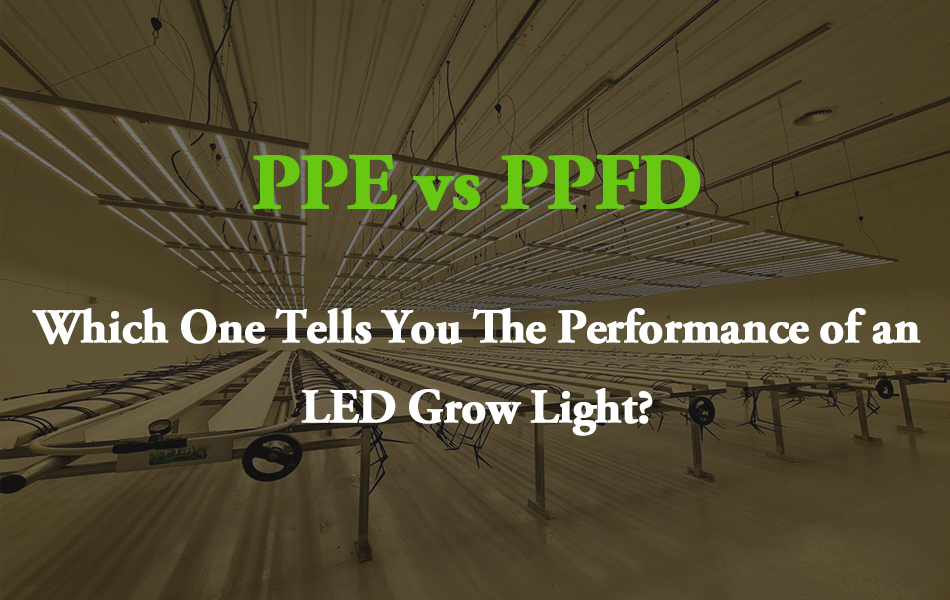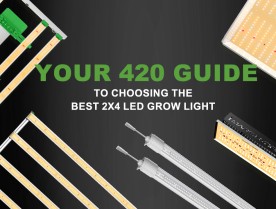
If you've been browsing the internet for a high-quality LED grow light, then you've likely come across the terms PAR, PPE, PPF, and PPFD. However, what's the meaning of PPFD, PPF, and PPE, and which one is the best to measure the performance of an LED grow light?
Continue reading below as we explain what these terms mean and which is the best measurement to use when comparing LED grow lights.
Conceptions You Need to Know
Before we jump into everything you need to know about PPE and PPFD, we need to understand a few different definitions which all growers are familiar with but always get confused about, and how they’re measured.

What's PAR?
PAR stands for photosynthetically active radiation, and it's the spectrum of light that plants can use for photosynthesis.
PAR is usually measured by professional machines or roughly measured with a PAR meter.
What's PPF?
PPF, or photosynthetic photon flux, is the total amount of light in the PAR zone produced by a grow light every second. That means that PPF is a valuable measurement of photosynthetically active photons.
PPF, in LED grow lights, describes the total amount of PAR light(photons) emitted by a fixture per second. The measurement is expressed in micromoles per second (μMol/s). (A μMol is the number of photons, and one micromole is 602 quadrillion photons.)
The precise measurement of the PPF must be performed in an integrating sphere.
What's PPE?
Photosynthetic photon efficiency (PPE) measures a grow light's efficiency for converting electrical energy into PAR light.
From the definition, we know easily how PPE is calculated - the total PAR light the fixture offers per second/the energy it consumes
PPE = PPF/Wattage
The measurement is expressed in μMol /watt/second, or more common to see as μMol per joule (μMol/j).
What's PPFD?
Photosynthetic photon flux density (PPFD) measures the amount of PAR light that actually arrives at a givenarea. So the PPFD tells you how much PAR light is hitting each part or each point of the canopy.
PPFD is usually tested in a grow tent or laboratory at a fixed height and a fixed area expressed as μMol per meter squared per second (μMol/m2/s). Merchants are supposed to provide a PPFD map of their fixtures to cultivators.
What's a Better Measurement: PPE or PPFD?
So you may be wondering “I can get PPE using PPFD by mathematics technical; they are the same thing expressing LED performance anyway.” Then you are in misconception.
TheyEvaluateDifferentAttributes
“I can get PPE using PPFD by mathematics technical.” How does it work?
The growers test the average PPFD with a PAR meter and then multiply the average PPFD value by the area tested - this is how growers typically obtain PPF values. After that, the PPE value is obtained by dividing the PPF value by the consumption power.
From the PPF value onwards, there is a problem. Due to the diffuse reflection of light and overlapping effects, etc, the PPF value can only be precisely tested in an integrating sphere. As a result, PPE, obtained in this way, is wrong.
You may wonder then does that mean the PAR meter is useless? Not exactly. The PPFD map you get from the meter is the real PPFD you will get in your future grow, and the PPF value is the “usable PPF” for your grow, though the “usable PPF” violates PPF’s definition.

Remember, PPE only measures an LED grow light’s efficiency at transforming electricity into light. That means that PPE can't tell you how well the fixture distributes light to a canopy.
For example, if you look at two different 650W LED grow lights, and they both have the same PPE of 2.8 μMol/j, does that mean they have the same performance? No, it only means that they have the same efficiency of converting 650w electric energy into the same amount of PAR light. It’s a good measurement of the light-converting ability of an LED grow light.
Instead, PPFD gives you a measurement of the light distribution over a certain amount of canopy space, that’s to say, the actual amount of PAR arrives on your canopy area per second. This is what cultivators care most about cause it describes the real energy from light to plants.
Lighting Uniformity is Essential
PPF, as we mentioned before, is the total amount of PAR light that a fixture provides. Once PPF and wattage are fixed, PPE is fixed. However, the PPF’s distribution pattern varies among LEDs, which is clearly shown in the PPFD map.
Let’s see several typical PPFD map - they all have the same PPE: 2.8umol/j.

Lighting uniformity is essential because the more evenly the light is distributed, the more light reaches across the canopy instead of leaking to the air or concentrating on one spot.
If an LED grow light has an uneven PPFD distribution, then that can lead to one hotspot that might burn your plants. Plants will also stretch toward the center for more light because of the lack of light surround them, as a result, the surrounding leaves will have much lower yields. Though some LEDs are designed to be so to serve as supplemental lighting in a greenhouse. However, these LEDs will definitely do no good to normal indoor grow.
However, you wouldn't know that if you only looked at the PPE measurement. That's why it's important to always take the LED grow light with a better PPFD map because that will make your plants grow their best.

In the end, we come to a conclusion that PPFD value is more reliable for growers to evaluate the performance of LED grow lights. Also, a small tip for picking any LEDs is that to clearly look at their PPFD maps. Don't be fooled by only high PPE measurements
Thanks for reading. Keep following up Mars Hydro official website for more blogs to explore into the growing world.
Grow On Earth, Grow With Mars.






